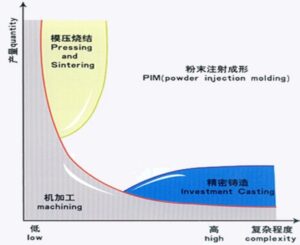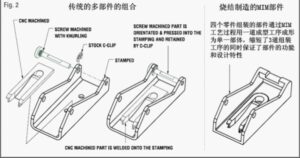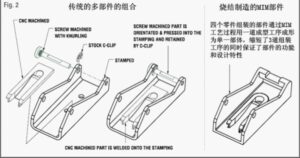Comparison Of MIM Processing And Other Processing
Powder particle of material used in mim is less than 15 μ m, however most of powder particle used in traditional powder metallurgy is in 50-100 μ m. The density of finished product of MIM process is high, as using a tiny powder. MIM process has the advantages of traditional powder metallurgy process, but traditional powder metallurgy can not achieve the high degree of freedom in the shape. Traditional powder metallurgy is limited to the strength of the mould and packing density, mostly in two-dimensional cylindrical shape.
Comparison Of MIM And Traditional Method
Die casting technology used in aluminum and zinc alloy, such as low melting point, casting liquid materials with good liquidity. The process of product because of the limitation of material, its strength, abrasion resistance and corrosion resistance are limited. The MIM process to processing of raw materials is more. Injection molding process technology using injection machines, injection molding products, guarantee the sufficient full of mold cavity (liquid metal casting mold filling is bad), is the realization of high complex structure to ensure the parts. Powder forging is an important development, which has been applied to production of connecting rod manufacturing. But in general, forging after heat treatment cost and the service life of mould or there is a problem, still to be further solved.
In recent years, the traditional machining method by automation and improved its processing capacity, on the effectiveness and accuracy have great progress, but the basic procedures are still on the processing step by step (turning, planing, milling, grinding, drilling, polishing, etc.) to complete a part shape.
Mechanical processing method of machining accuracy is far superior to other processing method, but because the material the effective utilization rate is low, and the completion of its shape is limited by equipment and tool, some parts will not be finished by machining. MIM, on the other hand, can effective use of material, not restricted, and the manufacturing of precision parts for small, hard shape, MIM technology comparison in terms of mechanical processing, its low cost and high efficiency, strong competitiveness.
Ever in the traditional processing technology into individual components and then assembled into components, can consider when use MIM technology integration into a complete single parts, greatly reducing step, simplify the processing procedure.
MIM technology does not compete with traditional processing methods, but make up for the inadequacy of traditional processing method on the technical defects or unable to make. The MIM technology can be in the field of traditional processing method of parts made on play its special features. The MIM process of technology advantage in parts manufacturing can forming highly complex structure parts.
The MIM compared with those of other metal processing method products high dimensional accuracy, need not for secondary processing or only a small amount of finishing. Injection molding process can be directly forming thin-walled, complicated structure, the product shape is close to the end product requirements, size tolerance parts generally remain at around 0.1 mm ~ + / – 0.3 mm. Especially for lower difficult to machining carbide processing cost, decrease the loss of precious metal process is of great significance in particular. Products uniform microstructure, high density, good performance.
MIM technology used in metal mould, its life and engineering plastic injection molding mold. Due to the use of metal mould, MIM is suitable for the mass production of parts. Due to the use of injection molding products blank, greatly improved the production efficiency, reduce the production cost, and the injection molding product consistency, repeatability is good, thus provides the guarantee for mass and large scale industrial production. Injection molding has a very wide range of materials (iron base, low alloy and high speed steel, stainless steel, tool steel, cemented carbide). In principle any hot water the knot of powder materials can be caused by MIM process parts, including the traditional manufacturing technology of hard processing material and high melting point materials. In addition, the MIM also can undertake material formula according to the requirement of the user study, making any combination of alloy material, the composite material molding parts. MIM technology USES the micron grade fine powder, can accelerate the sintering shrinkage, helps to increase mechanical properties of the materials, prolong the fatigue life of materials, and can improve the resistance to stress corrosion resistance, and magnetic energy. Had for hard, brittle hard cutting material or geometric shape of complex, casting material segregation or parts of pollution, the MIM technology can greatly save the cost. Processing typewriter printing element guide bar, for example, usually working procedure; Only 6 working procedure and use MIM technology, around half of the cost saving. Yue xiaoyue complex parts, the economic benefit will be better. Through the above analysis, we can see that the MIM forming potential is very great.
Advantages of metal injection molding technology.
Since the characteristics of metal injection molding with similar plastic injection molding, able to quickly and accurately design ideas materialized into a certain structure and functional properties of metal products for high-volume, suitable for mass production, therefore, metal injection molding technology has its unique advantage.
Metal injection molding compared with other technology, has the following advantages:
-
Cost advantage
-
Efficiency advantage
-
Performance advantage
● Shaped parts machining precision miniaturization advantages of composite material properties.For the opposite sex can not be micro-machined parts, metal injection molding technology has unique advantages.As hard and brittle materials and plastic composite material can be processed, while other methods does not have this advantage.
Harber Metal Group was founded in 2014 and is a national high-tech enterprise integrating R&D and production of powder metallurgy. The mim company has set up R&D center, testing center, metal powder forming (PM) division, powder injection molding (MIM) division and other industrial supporting facilities. It is a specialized, refined, special and new enterprise in Guangdong Province, an innovative enterprise in Guangdong Province, a science and technology small giant enterprise in Dongguan City, a director unit of Guangdong Powder Metallurgy Industry Technology Innovation Alliance, and an initiator of Dongguan Advanced Powder Metallurgy Cluster Promotion Center.

The Unseen Advantage: How Dedicated Support Fuels Fastest-Growing Companies

DIY or Pro Install? The Most Important Question to Ask Before Renting an LED Video Wall

Common Mistakes eCommerce Brands Make With Google Ads

Accelerating drug discovery through the DEL-ML-CS approach

AI in Marketing Is No Longer a Buzzword — It’s the Strategy

Why Theme Choice Matters for eCommerce Conversion Rates

How Low-Code Platforms Are Transforming Digital Account Opening for U.S. Banks

Best Phone Features for Students in 2025














